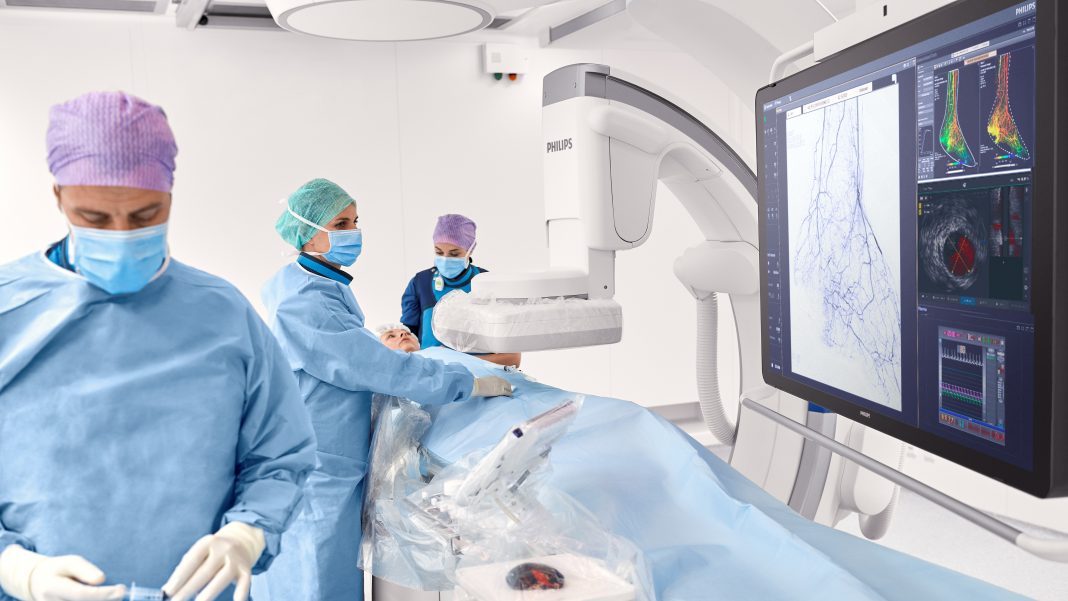Royal Philips (NYSE: PHG, AEX: PHIA), a global leader in health technology and IVUS solutions, today announced the results of a new large-scale real-world analysis of Centers for Medicare & Medicaid Services (CMS) data on the health outcomes of peripheral vascular interventions guided by intravascular ultrasound (IVUS).
The study was conducted independently by the Smith Center for Outcomes Research, with the results presented at the 2021 Transcatheter Cardiovascular Therapeutics (TCT) meeting by Eric A. Secemsky, MD, Director of Vascular Intervention and Interventional Cardiologist at Beth Israel Deaconess Medical Center and Assistant Professor of Medicine at Harvard Medical School in Boston, Massachusetts. The study, supported by Philips, underlines the company’s commitment to a strong evidence base for its innovations in the pursuit of better patient outcomes, enhanced patient and staff experiences, and lower cost of care.
Numerous prospective studies have already shown the benefit of IVUS guidance in peripheral vascular interventions, making it a gold-standard imaging modality for this application. The new study results now show that the outcome observations from these prior studies apply directly to a broader peripheral arterial and peripheral venous intervention patient population, demonstrating strong support for the use of IVUS during peripheral interventions.
Peripheral artery disease (PAD): a 32% reduction in major adverse limb events, including amputations, during lower extremity arterial interventions
The study looked at Medicare beneficiaries aged 65 years or older who underwent lower extremity arterial interventions between January 1, 2016, and December 31, 2019. Among 697,794 interventions, the investigators found a 32% reduction in major adverse limb events, such as amputations, over a median 425 days of follow-up. These findings were consistent across disease states, including critical limb ischemia and non-critical limb ischemia, as well as arterial segments such as the iliac (hip area), femoropopliteal (upper leg area) and tibial (lower leg area).
Peripheral artery disease develops when plaque builds up in the vessel wall and reduces blood flow to the limbs, most commonly the legs. It affects more than 8.5 million people in the USA [1]. PAD symptoms include recurrent fatigue, leg pain, and foot or leg wounds that do not heal or heal very slowly. Critical limb ischemia (CLI) is an advanced stage of PAD and is typically associated with high rates of cardiovascular events, amputations, and mortality. CLI patients have low survival rates, with 5-year mortality exceeding 50% [2].
Chronic venous disease (CVD): a 31% reduction in repeat intervention, hospitalization, or death during iliofemoral venous stenting
Separately, the investigators examined Medicare beneficiary data for patients treated between January 1, 2017, and December 31, 2019, in multiple clinical settings, including hospital in-patient settings, hospital outpatient centers, and private office-based clinics, involving 20,984 individual patients. Of these, 72% underwent stenting guided by IVUS. When IVUS was used, there was a 31% reduction in the composite outcome of repeat intervention, hospitalization, or death. In addition, IVUS use reduced the risk of stent thrombosis, embolization and stenosis.
Chronic venous disease (CVD) is both a common and underappreciated problem impacting over 30 million Americans [3]. Advanced CVD impacts over 6 million people in the USA and iliofemoral venous obstruction costs as much as USD 3 billion per year for ulcer care in advanced presentations [4].
“We commend Dr. Secemsky and the Smith Center for Outcomes Research for this on-going study to simplify clinical procedures and improve clinical and patient outcomes,” said Chris Landon, Senior Vice President and General Manager Image Guided Therapy Devices at Philips. “We are committed to supporting evidence-based medical guidelines in pursuit of better patient outcomes. We believe that the ability of IVUS to deliver procedure optimization and confidence enhances patient and staff experiences and lowers cost of care.”
First-ever global consensus for the appropriate use of IVUS in PVD interventions
In October 2021, a team of clinical experts led by Eric Secemsky, MD, established the first-ever global, cross-specialty expert consensus for the appropriate use of IVUS in peripheral vascular disease interventions. This initiative was jointly supported by Philips and Boston Scientific. Today, healthcare providers’ use of IVUS in PVD interventions is not standardized and is therefore inconsistent. The new appropriate-use expert consensus may help establish global standards of care to adopt into guidelines and improve quality of care in PVD.
To achieve consensus, the broad, multi-disciplinary group of global experts used a rigorous methodology. They conducted a systematic and comprehensive review of key clinical IVUS scenarios and decision-making processes before voting on the appropriate use consensus. Through this methodology, the group has established a clinical consensus to identify the optimal use of IVUS and potential knowledge gaps in order to set a standard across clinical specialties and drive positive outcomes for patients. Their findings were shared at a special symposium during Vascular Interventional Advances (VIVA) 2021.
Intravascular ultrasound (IVUS)
Philips is the global leader in IVUS solutions, which are part of the company’s comprehensive portfolio of systems, smart devices, software, and services for peripheral vascular disease aimed at helping clinicians decide, guide, treat, and confirm the right therapy for each patient during their procedure. Phased-array IVUS is an important imaging tool used during venous and arterial interventions. It provides the fast plug-and-play usability and high-fidelity image resolution needed for pre-procedural planning, intra-procedural guidance, and post-procedural optimization of therapy for patients. Using a miniaturized ultrasound transducer mounted on the tip of a catheter, it captures real-time images of vascular disease inside vessels, enabling physicians to standardize and improve procedure care for their patients. Additional workflow optimization is enabled by integrated suite offerings such as Philips’ Azurion 7 with IntraSight platform.
*The venous at the hip joint where the veins from the left and right leg come together into the abdominal aorta
[1] https://www.ahajournals.org/doi/pdf/10.1161/CIR.0000000000001005
[2] Duff S, Mafilios MS, Bhounsule P, Hasegawa JT. The burden of critical limb ischemia: a review of recent literature. Vasc Health Risk Manag. 2019;15:187-208. Published 2019 Jul 1. doi:10.2147/VHRM.S209241 & https://journals.sagepub.com/doi/full/10.1177/1358863X211028298
[3] https://www.ncbi.nlm.nih.gov/pmc/articles/PMC5920451/
[4] https://doi.org/10.1161/CIRCULATIONAHA.113.006898
